Human Tissue-Temperature Rise During Ultrasound Treatments With the Aquaflex Gel Pad
- PMID: 15173862
- PMCID: PMC419505
Human Tissue-Temperature Rise During Ultrasound Treatments With the Aquaflex Gel Pad
Abstract
OBJECTIVE: To measure tissue-temperature rise in the lateral aspect of the ankle during 10-minute ultrasound treatments with ultrasound gel (gel), a gel pad with a thin layer of ultrasound gel on the top (gel/pad), and a gel pad with a thin layer of ultrasound gel on the top and the bottom coated with ultrasound gel (gel/pad/gel). DESIGN AND SETTING: We used a 1 x 3 repeated-measures, crossover design. The dependent variables were tissue-temperature change and time to peak temperature. The independent variable was the type of ultrasound coupling medium. Treatment orders were randomly assigned, and all possible orders were assigned 3 times. A thermocouple was inserted through a 32-mm catheter at a depth of 1 cm into the target-tissue space, the posterior lateral aspect of the left ankle, halfway between the lateral malleolus and the Achilles tendon. Each treatment consisted of ultrasound delivered topically at 1 W/cm(2), 3 MHz, in the continuous mode for 10 minutes. SUBJECTS: Eighteen healthy, college-aged student volunteers (13 women, 5 men), with no history of ankle injury in the previous 6 months. MEASUREMENTS: Intratissue temperature, measured every 30 seconds for 10 minutes. RESULTS: Intratissue temperature increases during the 10-minute treatments were significantly greater for the ultrasound gel (7.72 degrees C +/- 0.52 degrees C) and the gel/pad/gel (6.68 degrees C +/- 0.52 degrees C) than for the gel/pad (4.98 degrees C +/- 0.52 degrees C). CONCLUSIONS: When ultrasound is applied over bony prominences, a gel pad should be covered with ultrasound gel on both sides to ensure optimal heating.
Figures
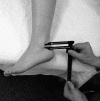


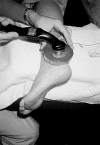
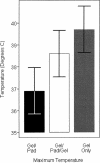
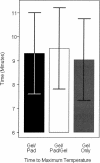
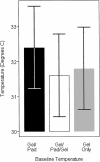
Similar articles
-
Temperature increases in the human achilles tendon during ultrasound treatments with commercial ultrasound gel and full-thickness and half-thickness gel pads.J Athl Train. 2010 Jul-Aug;45(4):333-7. doi: 10.4085/1062-6050-45.4.333. J Athl Train. 2010. PMID: 20617906 Free PMC article. Clinical Trial.
-
Hot-Pack and 1-MHz Ultrasound Treatments Have an Additive Effect on Muscle Temperature Increase.J Athl Train. 1998 Jan;33(1):21-4. J Athl Train. 1998. PMID: 16558479 Free PMC article.
-
A comparison of intramuscular temperatures during ultrasound treatments with coupling gel or gel pads.J Orthop Sports Phys Ther. 2002 May;32(5):216-20. doi: 10.2519/jospt.2002.32.5.216. J Orthop Sports Phys Ther. 2002. PMID: 12014825 Clinical Trial.
-
Three-MHz Ultrasound Heats Deeper Into the Tissues Than Originally Theorized.J Athl Train. 2004 Sep;39(3):230-234. J Athl Train. 2004. PMID: 15496991 Free PMC article.
-
Effect of coupling medium temperature on rate of intramuscular temperature rise using continuous ultrasound.J Athl Train. 2000 Oct;35(4):417-21. J Athl Train. 2000. PMID: 16558655 Free PMC article.
Cited by
-
Temperature increases in the human achilles tendon during ultrasound treatments with commercial ultrasound gel and full-thickness and half-thickness gel pads.J Athl Train. 2010 Jul-Aug;45(4):333-7. doi: 10.4085/1062-6050-45.4.333. J Athl Train. 2010. PMID: 20617906 Free PMC article. Clinical Trial.
-
Skin temperature changes during muscular static stretching exercise.J Exerc Rehabil. 2018 Jun 30;14(3):451-459. doi: 10.12965/jer.1836056.028. eCollection 2018 Jun. J Exerc Rehabil. 2018. PMID: 30018933 Free PMC article.
-
Blisters on the anterior shin in 3 research subjects after a 1-MHz, 1.5-W/cm , continuous ultrasound treatment: a case series.J Athl Train. 2007 Jul-Sep;42(3):425-30. J Athl Train. 2007. PMID: 18060000 Free PMC article.
-
Intramuscular temperature differences between the mid-point and peripheral effective radiating area with ultrasound.J Sports Sci Med. 2008 Jun 1;7(2):286-91. eCollection 2008. J Sports Sci Med. 2008. PMID: 24149462 Free PMC article.
-
The Effectiveness of Ultrasound Deep Heat Therapy for Adhesive Capsulitis: A Systematic Review and Meta-Analysis.Int J Environ Res Public Health. 2022 Feb 7;19(3):1859. doi: 10.3390/ijerph19031859. Int J Environ Res Public Health. 2022. PMID: 35162881 Free PMC article.
References
-
- Bracciano AG. Physical Agent Modalities: Theory and Application for the Occupational Therapist. Thorofare, NJ: FA Davis; 2000. Therapeutic ultrasound and phonophoresis; pp. 63–80.
-
- Draper DO, Schulthies S, Sovisto P, Hautala AM. Temperature changes in deep muscles of humans during ice and ultrasound therapies: an in vivo study. J Orthop Sports Phys Ther. 1995;21:153–157. - PubMed
-
- Draper DO, Sunderland S, Kirkendall DT, Ricard M. A comparison of temperature rise in human calf muscles following applications of underwater and topical gel ultrasound. J Orthop Sports Phys Ther. 1993;17:247–251. - PubMed
-
- Kramer JF. Ultrasound: evaluation of its mechanical and thermal effects. Arch Phys Med Rehabil. 1984;65:223–227. - PubMed
LinkOut - more resources
Full Text Sources
Other Literature Sources
